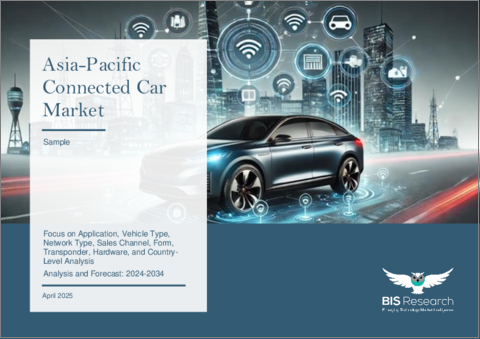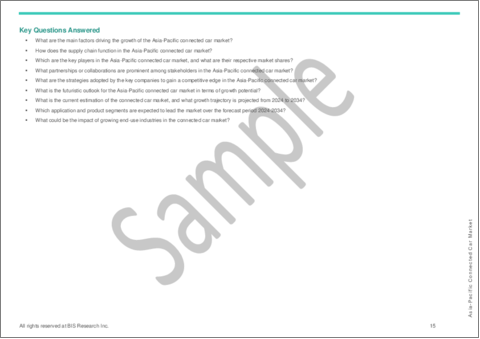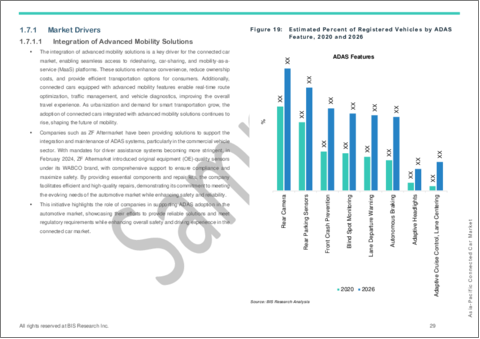|
|
市場調査レポート
商品コード
1716263
アジア太平洋のコネクテッドカー市場:用途別、車両タイプ別、ネットワークタイプ別、販売チャネル別、形態別、トランスポンダ別、ハードウェア別、国別 - 分析と予測(2024年~2034年)Asia-Pacific Connected Car Market: Focus on Application, Vehicle Type, Network Type, Sales Channel, Form, Transponder, Hardware, and Country-Level Analysis - Analysis and Forecast, 2024-2034 |
||||||
カスタマイズ可能
|
|||||||
| アジア太平洋のコネクテッドカー市場:用途別、車両タイプ別、ネットワークタイプ別、販売チャネル別、形態別、トランスポンダ別、ハードウェア別、国別 - 分析と予測(2024年~2034年) |
|
出版日: 2025年05月01日
発行: BIS Research
ページ情報: 英文 74 Pages
納期: 1~5営業日
|
- 全表示
- 概要
- 図表
- 目次
アジア太平洋のコネクテッドカーの市場規模は、2024年の392億7,000万米ドルから2034年には2,334億1,000万米ドルに達し、予測期間の2024年~2034年のCAGRは19.51%になると予測されています。
最先端の安全性、インフォテインメント、テレマティクス・ソリューションに対する顧客ニーズの高まりが、アジア太平洋におけるC-V2X通信、AI主導のモビリティ・サービス、成長する5Gネットワークの急速な導入を促進しています。政府の安全規制、都市化の進展、電動化と自律走行の野心的な目標に対応するため、アジア太平洋地域のOEMとフリート事業者は採用を加速しています。Toyota、Hyundai、Honda、Densoなどの著名企業や、新進気鋭のデジタル新興企業は、スマート・テレマティクス、連携モビリティ・プラットフォーム、無線ソフトウェア・アップデートに多額の投資を行っています。戦略的な官民連携、国家的なスマートシティ・イニシアチブ、5Gインフラの建設などの支援により、アジア太平洋はモビリティ・アズ・ア・サービス(MAAS)と次世代車両接続の進歩における世界の中心地としての地位を確立しつつあります。
| 主要市場統計 | |
|---|---|
| 予測期間 | 2024年~2034年 |
| 2024年の評価 | 392億7,000万米ドル |
| 2034年予測 | 2,334億1,000万米ドル |
| CAGR | 19.51% |
急速な都市化、5Gインフラの成長、最先端のモビリティ・ソリューションに対する消費者の需要の高まりが、アジア太平洋(アジア太平洋)のコネクテッド自動車市場を牽引しています。インフォテインメント、テレマティクス、予知保全、リアルタイム・ナビゲーション、V2X(Vehicle-to-Everything)接続などの技術により、この地域のコネクテッド・カーは運転効率、安全性、利便性を向上させています。
スマートモビリティ、交通安全、排出ガス削減を奨励する強力な政府プログラムの支援を受けて、中国、日本、韓国、インドなどの国々がコネクテッド・テクノロジーの採用の先陣を切っています。変化する市場ニーズに対応するため、OEMや技術プロバイダーは、OTA(Over-the-Air)アップデート機能、ソフトウェア定義車両、AI搭載テレマティクスに多額の投資を行っています。消費者、インフラ、自動車をつなぐ統合デジタル・エコシステムへの需要は、電気自動車(EV)の人気の高まりによってさらに高まっています。
市場の見通しは依然として良好だが、規制の枠組みがバラバラであること、サイバーセキュリティの脅威、農村部と都市部の接続が不均一であることなどの問題が残っています。また、特に新興経済諸国では、購入しやすい価格への懸念も普及に影響しています。しかし、官民協力の継続、5G導入の改善、自律型・共有型交通ソリューションの重視の高まりにより、今後数年間で、アジア太平洋は次世代コネクテッド・モビリティ技術の世界的中心地として位置づけられると予想されます。
アジア太平洋地域のコネクテッドカー市場動向と促進要因・課題
動向
アジア太平洋のコネクテッドカー市場は、5Gコネクティビティ、C-V2X通信、AI主導のテレマティクス、クラウドベースのインフォテインメントシステムの導入により急速に拡大しています。スマート交通ソリューションの大規模展開と自律走行車開発への大規模投資は、中国、日本、韓国、インドなどの国々が主導しています。予知保全、OTA(Over-the-Air)アップデート、パーソナライズされた車載サービスが可能になるため、ソフトウェア定義の車両アーキテクチャが人気を集めています。ユーザー・エクスペリエンスと業務効率を改善する統合デジタル・エコシステムに対する需要は、電気自動車(EV)の成長によってさらに高まっています。
促進要因
この地域の主な要因としては、急速な都市化、交通安全向上のニーズの高まり、政府主導のスマートシティプロジェクトなどが挙げられます。ADAS(先進運転支援システム)、緊急通報機能、公害監視を義務付ける厳しい規制により、技術導入が加速しています。スマートフォンの普及拡大、5Gインフラの開発、コネクテッド・ライフスタイルに対する消費者の期待の高まりなどの要因により、OEMはデジタル機能を最優先するよう迫られています。アジア太平洋全域でインテリジェント交通システムやV2I(Vehicle-to-Infrastructure)プロジェクトを大規模に実施することも、官民パートナーシップによって奨励されています。
課題
主な障害としては、異なる法制度、高価な連携機器、国によって異なる5Gネットワークのカバー範囲などが挙げられます。標準化された通信方法の不在、サイバーセキュリティのリスク、データ・プライバシーの問題は、円滑な接続性を阻害しています。さらに、アジア太平洋の開発途上国では、価格に敏感な顧客の間では、価格設定が引き続き普及を妨げる要因となっています。
当レポートは、アジア太平洋のコネクテッドカー市場に関する詳細な洞察を提供し、情報に基づいた意思決定と戦略立案を可能にすることで、組織に付加価値を与えます。新たな技術、市場動向、競合力学を明らかにし、企業が成長機会を特定し、提供する製品を業界の需要に適合させるのに役立ちます。当レポートの詳細なセグメンテーションと地域分析は、的を絞った市場参入戦略をサポートし、規制フレームワークとサイバーセキュリティ対策を網羅することで、進化する業界標準への準拠を保証します。当レポートを活用することで、企業はイノベーションを推進し、業務効率を向上させ、急速に進化するコネクテッドモビリティのエコシステムにおいて競争力を獲得し、持続可能な成長と技術的リーダーシップを確保することができます。
当レポートでは、アジア太平洋のコネクテッドカー市場について調査し、市場の概要とともに、用途別、車両タイプ別、ネットワークタイプ別、販売チャネル別、形態別、トランスポンダ別、ハードウェア別、国別の動向、および市場に参入する企業のプロファイルなどを提供しています。
目次
エグゼクティブサマリー
第1章 市場
- 動向:現状と将来への影響評価
- サプライチェーンの概要
- 研究開発レビュー
- 規制状況
- ステークホルダー分析
- 主要イベントの影響分析
- 市場力学:概要
第2章 地域
- 地域のサマリー
- アジア太平洋
- 地域概要
- 市場成長促進要因
- 市場成長抑制要因
- 用途
- 製品
- アジア太平洋(国別)
第3章 市場-競合ベンチマーキングと企業プロファイル
- 今後の見通し
- 地理的評価
第4章 調査手法
List of Figures
- Figure 1: Asia-Pacific Connected Car Market (by Scenario), $Billion, 2024, 2027, and 2034
- Figure 2: Connected Car Market (by Region), $Billion, 2023, 2027, and 2034
- Figure 3: Asia-Pacific Connected Car Market (by Application), $Billion, 2023, 2027, and 2034
- Figure 4: Asia-Pacific Connected Car Market (by Vehicle Type), $Billion, 2023, 2027, and 2034
- Figure 5: Asia-Pacific Connected Car Market (by Network Type), $Billion, 2023, 2027, and 2034
- Figure 6: Asia-Pacific Connected Car Market (by Sales Channel), $Billion, 2023, 2027, and 2034
- Figure 7: Asia-Pacific Connected Car Market (by Form), $Billion, 2023, 2027, and 2034
- Figure 8: Asia-Pacific Connected Car Market (by Transponder), $Billion, 2023, 2027, and 2034
- Figure 9: Asia-Pacific Connected Car Market (by Hardware), $Billion, 2023, 2027, and 2034
- Figure 10: Key Events
- Figure 11: Vehicle Theft Incidents for 2019 and 2023 (Per 10,000 People)
- Figure 12: Breakdown of Motor Vehicle Theft (by Vehicle Type), 2019-2023
- Figure 13: Supply Chain and Risks within the Supply Chain
- Figure 14: Value Chain Analysis
- Figure 15: Connected Car Market Pricing Forecast, $/Car Technology, 2023-2034
- Figure 16: Patent Analysis (by Country), January 2021-November 2024
- Figure 17: Patent Analysis (by Company), January 2021-November 2024
- Figure 18: Impact Analysis of Market Navigating Factors, 2023-2034
- Figure 19: Estimated Percent of Registered Vehicles by ADAS Feature, 2020 and 2026
- Figure 20: Imported Luxury Car Sales in South Korea, Units, 2018-2023
- Figure 21: China Connected Car Market, $Billion, 2023-2034
- Figure 22: Japan Connected Car Market, $Billion, 2023-2034
- Figure 23: India Connected Car Market, $Billion, 2023-2034
- Figure 24: South Korea Connected Car Market, $Billion, 2023-2034
- Figure 25: Rest-of-Asia-Pacific Connected Car Market, $Billion, 2023-2034
- Figure 26: Strategic Initiatives, January 2021-November 2024
- Figure 27: Data Triangulation
- Figure 28: Top-Down and Bottom-Up Approach
- Figure 29: Assumptions and Limitations
List of Tables
- Table 1: Market Snapshot
- Table 2: Opportunities across Region
- Table 3: Trends Overview
- Table 4: Top-Ranking UBI Insurers (by Region) and Customer Satisfaction Scores
- Table 5: Regulatory Landscape for the Connected Car Market
- Table 6: Connected Car Market (by Region), $Billion, 2023-2034
- Table 7: Asia-Pacific Connected Car Market (by Application), $Billion, 2023-2034
- Table 8: Asia-Pacific Connected Car Market (by Vehicle Type), $Billion, 2023-2034
- Table 9: Asia-Pacific Connected Car Market (by Network Type), $Billion, 2023-2034
- Table 10: Asia-Pacific Connected Car Market (by Sales Channel), $Billion, 2023-2034
- Table 11: Asia-Pacific Connected Car Market (by Form), $Billion, 2023-2034
- Table 12: Asia-Pacific Connected Car Market (by Transponder), $Billion, 2023-2034
- Table 13: Asia-Pacific Connected Car Market (by Hardware), $Billion, 2023-2034
- Table 14: China Connected Car Market (by Application), $Billion, 2023-2034
- Table 15: China Connected Car Market (by Vehicle Type), $Billion, 2023-2034
- Table 16: China Connected Car Market (by Network Type), $Billion, 2023-2034
- Table 17: China Connected Car Market (by Sales Channel), $Billion, 2023-2034
- Table 18: China Connected Car Market (by Form), $Billion, 2023-2034
- Table 19: China Connected Car Market (by Transponder), $Billion, 2023-2034
- Table 20: China Connected Car Market (by Hardware), $Billion, 2023-2034
- Table 21: Japan Connected Car Market (by Application), $Billion, 2023-2034
- Table 22: Japan Connected Car Market (by Vehicle Type), $Billion, 2023-2034
- Table 23: Japan Connected Car Market (by Network Type), $Billion, 2023-2034
- Table 24: Japan Connected Car Market (by Sales Channel), $Billion, 2023-2034
- Table 25: Japan Connected Car Market (by Form), $Billion, 2023-2034
- Table 26: Japan Connected Car Market (by Transponder), $Billion, 2023-2034
- Table 27: Japan Connected Car Market (by Hardware), $Billion, 2023-2034
- Table 28: India Connected Car Market (by Application), $Billion, 2023-2034
- Table 29: India Connected Car Market (by Vehicle Type), $Billion, 2023-2034
- Table 30: India Connected Car Market (by Network Type), $Billion, 2023-2034
- Table 31: India Connected Car Market (by Sales Channel), $Billion, 2023-2034
- Table 32: India Connected Car Market (by Form), $Billion, 2023-2034
- Table 33: India Connected Car Market (by Transponder), $Billion, 2023-2034
- Table 34: India Connected Car Market (by Hardware), $Billion, 2023-2034
- Table 35: South Korea Connected Car Market (by Application), $Billion, 2023-2034
- Table 36: South Korea Connected Car Market (by Vehicle Type), $Billion, 2023-2034
- Table 37: South Korea Connected Car Market (by Network Type), $Billion, 2023-2034
- Table 38: South Korea Connected Car Market (by Sales Channel), $Billion, 2023-2034
- Table 39: South Korea Connected Car Market (by Form), $Billion, 2023-2034
- Table 40: South Korea Connected Car Market (by Transponder), $Billion, 2023-2034
- Table 41: South Korea Connected Car Market (by Hardware), $Billion, 2023-2034
- Table 42: Rest-of-Asia-Pacific Connected Car Market (by Application), $Billion, 2023-2034
- Table 43: Rest-of-Asia-Pacific Connected Car Market (by Vehicle Type), $Billion, 2023-2034
- Table 44: Rest-of-Asia-Pacific Connected Car Market (by Network Type), $Billion, 2023-2034
- Table 45: Rest-of-Asia Pacific Connected Car Market (by Sales Channel), $Billion, 2023-2034
- Table 46: Rest-of-Asia-Pacific Connected Car Market (by Form), $Billion, 2023-2034
- Table 47: Rest-of-Asia-Pacific Connected Car Market (by Transponder), $Billion, 2023-2034
- Table 48: Rest-of-Asia-Pacific Connected Car Market (by Hardware), $Billion, 2023-2034
- Table 49: Market Share,2023
Introduction to Asia-Pacific Connected Car Market
The Asia-Pacific connected car market is projected to reach $233.41 billion by 2034 from $39.27 billion in 2024, growing at a CAGR of 19.51% during the forecast period 2024-2034. Growing customer demand for cutting-edge safety, infotainment, and telematics solutions is driving the Asia-Pacific region's rapid adoption of C-V2X communication, AI-driven mobility services, and growing 5G networks. In response to government safety regulations, growing urbanisation, and ambitious goals for electrification and autonomous driving, OEMs and fleet operators throughout Asia-Pacific are speeding up adoption. Prominent corporations including Toyota, Hyundai, Honda, Denso, and up-and-coming digital startups are making significant investments in smart telematics, linked mobility platforms, and over-the-air software updates. With the help of strategic public-private collaborations, national smart city initiatives, and the construction of 5G infrastructure, Asia-Pacific is establishing itself as a global centre for advancements in mobility-as-a-service (MAAS) and next-generation vehicle connection.
Market Introduction
| KEY MARKET STATISTICS | |
|---|---|
| Forecast Period | 2024 - 2034 |
| 2024 Evaluation | $39.27 Billion |
| 2034 Forecast | $233.41 Billion |
| CAGR | 19.51% |
Rapid urbanisation, growing 5G infrastructure, and growing consumer demand for cutting-edge mobility solutions are driving the connected automobile market in Asia-Pacific (APAC). With technologies like infotainment, telematics, predictive maintenance, real-time navigation, and vehicle-to-everything (V2X) connection, connected cars in the area improve driving efficiency, safety, and convenience.
With the help of robust government programs encouraging smart mobility, road safety, and emissions reduction, nations like China, Japan, South Korea, and India are spearheading the adoption of linked technologies. To meet changing market needs, OEMs and technology providers are making significant investments in over-the-air (OTA) update capabilities, software-defined vehicles, and AI-powered telematics. The demand for integrated digital ecosystems that link consumers, infrastructure, and cars is being further fuelled by the rising popularity of electric vehicles (EVs).
The market prognosis is still favourable, but there are still issues including disparate regulatory frameworks, cybersecurity threats, and uneven connection in rural and urban areas. Concerns about affordability also affect widespread adoption, particularly in developing APAC economies. However, it is anticipated that in the upcoming years, APAC will be positioned as a global centre for next-generation connected mobility technologies due to continued public-private collaborations, improvements in 5G implementation, and a growing emphasis on autonomous and shared transportation solutions.
Market Segmentation
Segmentation 1: by Application
- Mobility Management
- Telematics
- Infotainment
- Driver Assistance
- Navigation
- Others (eCall, Autopilot, Remote Diagnostics, Home Integration)
Segmentation 2: by Vehicle Type
- Internal Combustion Engine (ICE) Vehicle
- Battery Electric Vehicle (BEV)
- Hybrid Electric Vehicle (HEV)
- Plug-in Hybrid Electric Vehicle (PHEV)
Segmentation 3: by Network Type
- Operational Data
- Dedicated Short-Range Communication (DSRC)
- Cellular
- Satellite
Segmentation 4: by Sales Channel
- Original Equipment Manufacturer (OEM)
- Aftermarket
Segmentation 5: by Form
- Embedded
- Integrated
Segmentation 6: by Transponder
- Onboard Unit
- Roadside Unit
Segmentation 7: by Hardware
- Head Unit
- Central Gateway
- Intelligent Antennas
- Electronic Control Unit (ECU)
- Telematics Control Unit
- Keyless Entry System
- Sensors
Segmentation 8: by Region
- Asia-Pacific (China, Japan, India, South Korea, and Rest-of-Asia-Pacific)
APAC Connected Car Market Trends, Drivers and Challenges-
Trends
The APAC connected car market is fast expanding with the incorporation of 5G connectivity, C-V2X communication, AI-driven telematics, and cloud-based infotainment systems. Large-scale rollouts of smart transportation solutions and significant investments in autonomous vehicle development are being spearheaded by nations like China, Japan, South Korea, and India. Because they enable predictive maintenance, over-the-air (OTA) updates, and personalised in-car services, software-defined vehicle architectures are gaining popularity. Demand for integrated digital ecosystems that improve user experience and operational efficiency is being further bolstered by the growth of electric vehicles (EVs).
Drivers
Key factors in the area include the region's rapid urbanisation, rising need for improved road safety, and government-led smart city projects. Technology adoption is being accelerated by strict regulations requiring advanced driver-assistance systems (ADAS), emergency call capabilities, and pollution monitoring. OEMs are being pressured to give digital features top priority due to factors like growing smartphone adoption, developing 5G infrastructure, and growing consumer expectations for connected lifestyles. Large-scale implementation of intelligent transport systems and vehicle-to-infrastructure (V2I) projects throughout Asia Pacific is also being encouraged by public-private partnerships.
Challenges
Major obstacles include disparate legislative regimes, expensive linked devices, and uneven 5G network coverage across nations. The absence of standardised communication methods, cybersecurity risks, and data privacy issues impede smooth connectivity. Furthermore, in developing APAC nations, pricing continues to be a deterrent to wider adoption among price-conscious customers.
How can this report add value to an organization?
This report adds value to an organization by providing in-depth insights into the APAC connected car market, enabling informed decision-making and strategic planning. It highlights emerging technologies, market trends, and competitive dynamics, helping organizations identify growth opportunities and align their offerings with industry demands. The report's detailed segmentation and regional analysis support targeted market entry strategies, while its coverage of regulatory frameworks and cybersecurity measures ensures compliance with evolving industry standards. By leveraging this report, organizations can drive innovation, enhance operational efficiency, and gain a competitive edge in the rapidly evolving connected mobility ecosystem, ensuring sustainable growth and technological leadership.
Table of Contents
Executive Summary
Scope and Definition
1 Markets
- 1.1 Trends: Current and Future Impact Assessment
- 1.1.1 Increasing Consumer Focus on Enhanced Anti-Theft Solutions
- 1.1.2 Growing Popularity of Usage-Based Insurance (UBI)
- 1.2 Supply Chain Overview
- 1.2.1 Value Chain Analysis
- 1.2.2 Pricing Forecast
- 1.3 Research and Development Review
- 1.3.1 Patent Filing Trend (by Country and Company)
- 1.4 Regulatory Landscape
- 1.5 Stakeholder Analysis
- 1.5.1 End User and Buying Criteria
- 1.6 Impact Analysis for Key Events
- 1.6.1 COVID-19
- 1.6.2 Russia/Ukraine War
- 1.7 Market Dynamics: Overview
- 1.7.1 Market Drivers
- 1.7.1.1 Integration of Advanced Mobility Solutions
- 1.7.1.2 Growing Demand for Premium Vehicles Owing to Inclination of Consumers toward Comfort and Luxury
- 1.7.2 Market Restraints
- 1.7.2.1 Lack of Connectivity Infrastructure to Restrain Growth
- 1.7.2.2 Challenges in Ensuring Data Privacy and Security
- 1.7.3 Market Opportunities
- 1.7.3.1 Integration with Home Automation Systems
- 1.7.3.2 Leveraging Data for Monetization Opportunities
- 1.7.1 Market Drivers
2 Region
- 2.1 Regional Summary
- 2.2 Asia-Pacific
- 2.2.1 Regional Overview
- 2.2.2 Driving Factors for Market Growth
- 2.2.3 Factors Challenging the Market
- 2.2.4 Application
- 2.2.5 Product
- 2.2.6 Asia-Pacific (by Country)
- 2.2.6.1 China
- 2.2.6.1.1 Application
- 2.2.6.1.2 Product
- 2.2.6.2 Japan
- 2.2.6.2.1 Application
- 2.2.6.2.2 Product
- 2.2.6.3 India
- 2.2.6.3.1 Application
- 2.2.6.3.2 Product
- 2.2.6.4 South Korea
- 2.2.6.4.1 Application
- 2.2.6.4.2 Product
- 2.2.6.5 Rest-of-Asia-Pacific
- 2.2.6.5.1 Application
- 2.2.6.5.2 Product
- 2.2.6.1 China
3 Markets - Competitive Benchmarking & Company Profiles
- 3.1 Next Frontiers
- 3.2 Geographic Assessment
4 Research Methodology
- 4.1 Data Sources
- 4.1.1 Primary Data Sources
- 4.1.2 Secondary Data Sources
- 4.1.3 Data Triangulation
- 4.2 Market Estimation and Forecast






